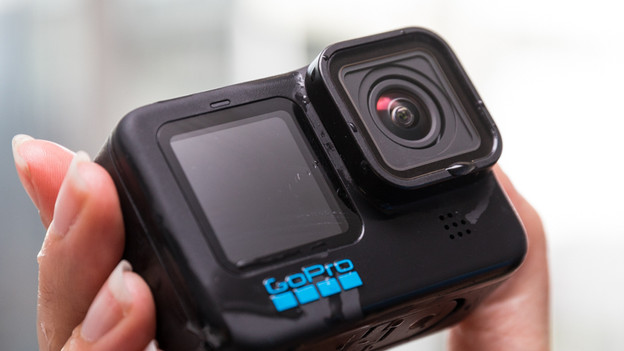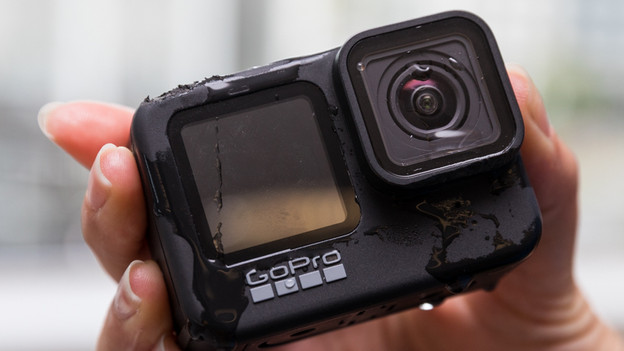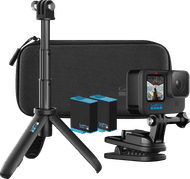
Written by Manon
Edited on
13 October 2025
·
14:53
Compare the GoPro HERO 10 to the GoPro HERO 9
The GoPro action cameras often look alike, as do the GoPro HERO 10 and HERO 9. You can recognize the HERO 10 by the blue logo. Both cameras record in 5.3K resolution. They mostly differ in the number of frames per second they record with. Read everything on the differences and similarities between the 2 models here.
GoPro HERO 10 Black
- Thanks to the high frame rate in 5K with 60 fps and 4K with 120 fps, you can record smooth footage.
- The HyperSmooth 4.0 image stabilization ensures stable video footage.
- The selfie screen has a higher refresh rate, so the footage looks smoother.
- The action camera doesn't include a memory card.
GoPro HERO 10 and HERO 9 comparison
| HERO 10 | HERO 9 | |
|---|---|---|
| Processor | GP2 | GP1 |
| Image stabilization | HyperSmooth 4.0 | HyperSmooth 3.0 |
| Video resolution | 5.3K, 60 fps - 4K, 120 fps | 5.3K, 30fps - 4K, 60 fps |
| Photo resolution | 23 megapixels | 20 megapixels |
| Refresh rate selfie screen | 30 frames | 5 frames |
| Maximum tilt horizon stabilization | 45 degrees | 27 degrees |
| Special lens coating | Yes | No |
Video resolution

HERO 10: records in 5.3K with 60 fps and in 4K with 120 fps
Thanks to the improved processor, the HERO 10 records with 2 times higher frame rates than the HERO 9. In 5.K resolution, it records with up to 60 fps. If you record in 4K, you can record with up to 120 fps. Thanks to the high frame rates, you can easily slow down images to create slow motions that look sharp and smooth. You can use it to highlight a somersault or funny moment.

HERO 9: records in 5.3K with fps and in 4K with 60 fps
The HERO 9 has the first generation GoPro processor, so it doesn't reach the high frame rates that the does. You can record in 5K resolution with this action camera, with 30 fps. In 4K, the HERO 9 records with 60 fps. If you record sharp and smooth slow motion footage, you use a 2.7K or Full HD resolution. And you record with 120 or 240 fps, respectively.
Image stabilization

HERO 10: HyperSmooth 4.0
With HyperSmooth 4.0, GoPro improved image stabilization a bit more. You don't need a gimbal to record smooth videos, for example. The horizon stabilization was also improved. You can tilt the camera up to 45 degrees and the camera keeps the horizon straight. If you tilt the camera further, the image switches to the position of the camera. The horizon stabilization doesn't work with the maximum frame rates. Your camera crops the image because the horizon stabilization is electronic.

HERO 9: HyperSmooth 3.0
The GoPro HERO 9 has HyperSmooth 3.0 image stabilization. Your images almost look as smooth as with a gimbal. So you can easily record smooth and stable footage. If you use the horizon stabilization, you can tilt the HERO 9 up to 27 degrees. After that, the image rotates along with the position of the camera. You can't tilt the HERO 9 as far as the HERO 10. And the camera also crops the image with this horizon stabilization.
Physical properties

HERO 10: selfie screen 30-frame refresh rate
The new model also has the familiar selfie screen of the HERO 9. The refresh rate of the screen was optimized. This means that the footage looks smoother. The replaceable lens cover of the HERO 10 has a special coating. Drops of water fall off of it faster as a result. That's useful when you go surfing and submerge the camera often. This way, you won't be bothered by annoying drops in your videos.

HERO 9: selfie screen 5-frame refresh rate
Due to the relatively low refresh rate of the HERO 9 selfie screen, footage looks a bit choppy. There's a delay, because the screen has a 5-frame refresh rate. That's much lower than the 30 frames of the HERO 10. The HERO 9 has a replaceable lens cover without the special coating. That means that drops stay on the lens cover and are sometimes visible in your videos. That's why you have to dry it off.
Conclusion
If you switch from a GoPro HERO 9 to a HERO 10, the difference isn't big. Both cameras record in 5.3K resolution. The most important difference is in the frame rates. With the HERO 10, you can record with double the amount of frames per second for a smoother result. This is also more suitable for slow motion videos. Thanks to the improved horizon stabilization, the camera tilts further. In addition, the lens cover has a coating, so drops of water fall off of it more easily than they do with the HERO 9.

